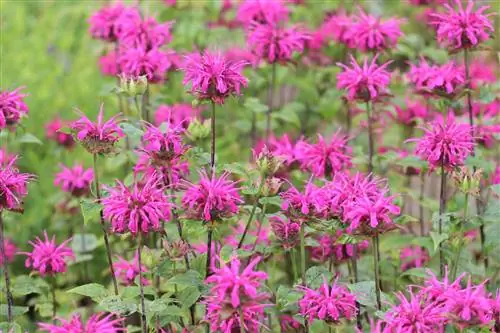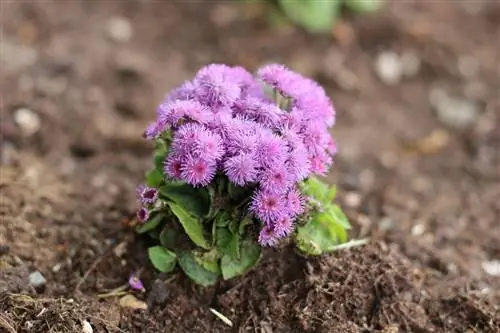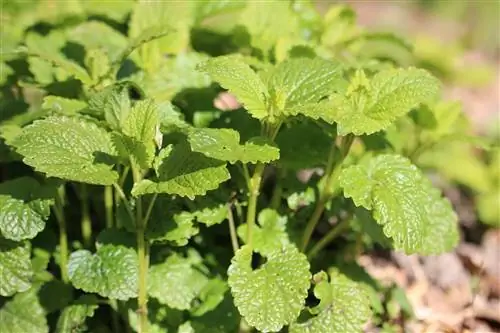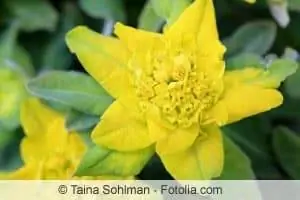- Author admin [email protected].
- Public 2023-12-17 03:39.
- Last modified 2025-06-01 06:48.
The golden balm with its bright red and exceptionally attractive flowers is still relatively unknown in temperate climates. It has numerous advantages to offer. Surprisingly large and undemanding, the herbaceous plant is extremely easy to care for. In addition, it can not only be used in the kitchen, but its essential oils also keep pests away from itself and the surrounding plants. Decorative, easy to care for and useful, it is an all-round asset to the garden.
Location
Originating from North America, golden balm prefers bright, warm locations that also have high humidity. They therefore thrive best near a watercourse or garden pond - as long as they get enough sun. At least light shade is required. In addition, it should be noted that the golden balm can grow up to 150 cm high. If you don't want to constantly reach for scissors, you should plan enough upward space.
Substrate
The golden balm also needs constant moisture in the soil, but cannot tolerate waterlogging. The substrate must therefore be able to store water and be permeable at the same time. A humus-rich, loose soil, such as special herb soil, is ideal. Also suitable as a substrate is a mixture in equal parts of:
- Coconut Fiber
- Ripe, well-rotted compost
- fresh plant or garden soil
When mixed well, this combination is rich in nutrients, remains loose, stores water evenly and releases it gradually. So it’s ideal for the needs of golden balm. In addition, the maintenance effort is reduced.
Planting and sowing
If the golden balm has grown safely in the garden and has been hardened over the year, it can withstand frost without any problems. However, this does not yet apply to young plants. These can therefore only be planted freely in the garden from May, when sub-zero temperatures are no longer to be expected. The same applies to sowing outdoors. This should also take place in May at the earliest. As light germinators, the seeds are only thinly covered with substrate and kept well moist. If the seeds germinate, they are a popular source of food for snails in the beginning and are also quite vulnerable. It therefore makes more sense to rely on young plants or to grow seeds indoors.
Pre-breeding
Pre-cultivation of the golden balm can begin in February or March and is carried out as follows:
- The smallest possible or specially divided growing containers are filled with seed, herb or growing soil. Pure coconut fiber is also suitable as a substrate.
- The selected substrate is well moistened.
- The seeds of the golden balm can be placed simply on the ground or covered very thinly with it.
- The vessels are placed in an indoor greenhouse or covered with transparent film and then moved to a bright, warm location. However, they should not be exposed to blazing sun.
- To avoid mold, the cover or greenhouse should be ventilated daily. Nevertheless, the substrate must be kept moist throughout.
After six to eight weeks, the young plants are large enough to be planted outdoors. However, the change should not be done abruptly, but only when the small golden balm plants have gradually been freed from the cover.
Pouring
If the golden balm has been planted next to a pond or watercourse, additional watering is usually not necessary. The situation is different when growing in containers or in drier locations. Watering should be carried out as needed, whenever the substrate surface is no longer moist or the plant shows signs of dryness. It is best to use soft water for watering. For example, untreated pond, rain or stale tap water.
Fertilize
Since the golden balm grows quite quickly, it benefits from additional nutrients. It can therefore be fertilized once a month from the first shoots in spring until September. Suitable means are:
- Herbal fertilizer
- Mature compost
- Pond water
- Algae
If planted in fresh soil, however, it can be dispensed with in the first year. Even after this, fertilizing the golden balm is not absolutely necessary, but recommended. The additional supply of nutrients ensures increased flowering and increased resistance.
Cutting
A topiary cut is not necessary for the golden balm, but a radical trimming in autumn or spring is. You wait until all parts above ground have dried out. These are then removed a hand's breadth above the ground. Nothing needs to be taken into account in autumn or winter. In the spring, however, good timing is crucial, as the measure must take place before budding. Otherwise this can be delayed or new shoots will be damaged.
Propagation
Golden balm can be propagated by seeds and division. However, obtaining the seeds is quite complex and requires a lot of sensitivity. However, it is much easier to divide the adult plant. This measure also has the advantages of reducing and rejuvenating the plant. The smaller size makes it less susceptible to fungal infestation. The rejuvenating effect stimulates flowering power, which can decrease in older specimens. The following steps are necessary to divide the golden balm:
- Before budding in spring, the golden balm is carefully dug up and thoroughly freed from the old substrate. It is advisable to rinse the roots for this purpose.
- Root and plant are divided lengthwise as far as possible in the middle. A clean spade, scissors or a sharp knife can be used for this. It is best to disinfect the blades beforehand.
- So that the cut surfaces can dry sufficiently, the plant halves should be allowed to rest for a few hours.
- The two halves are then placed separately in fresh substrate and watered well.
Of course, a frost-free day should be chosen for this measure. This not only makes digging and planting easier, but also protects the plants.
Wintering
If the golden balm was planted freely in the garden in spring, it will have grown and hardened sufficiently at the beginning of winter. Protection against frost is not necessary here. The plant retreats into the roots in autumn and does not require insulation against sub-zero temperatures. The situation is different when cultivating golden balm in the bucket. Here it makes sense to wrap the container with several layers of garden fleece, mats or old blankets to prevent it from freezing completely. The bucket can also be brought into the house and placed here in a cold but frost-free place. Complete drying out should be avoided, but the plant does not need light or fertilizer.
Conclusion
The golden balm requires little care if the location and substrate are selected appropriately. Due to its low demands and extremely simple cultivation, it is ideal for inexperienced hobby gardeners, but is still an aromatic enrichment in the garden that can even be used in the kitchen.
- The real Indian nettle (Monarda) is a very versatile plant. However, today almost only hybrids are offered.
- Both are good cut flowers and great garden perennials, but the hybrids no longer have the medicinal properties of the parent plants.
- Today, hybrids of M. didyma and M. fistulosa are usually offered: uncomplicated species that do not place great demands on the location.
- The leaves of the Indian nettle can be used in the kitchen even without any medicinal properties. Or you can make a syrup from it.
- Harvested during the flowering period from June to October.
- Aromatic teas are still made today from the bergamot-scented leaves of the scarlet Indian nettle.
Indian soul and mildew
- Mildew is relatively common.
- The fungus loves changing temperatures and persistent dryness.
- You can recognize powdery mildew by the whitish coating on the upper side of the leaves.
- Help is prevention.
- Ideal location, sufficient planting distance, pruning after flowering and watering in dry conditions
- Select resistant varieties, e.g. 'Aquarius', 'Fishes' or 'Purple Ann'.
- The fungus itself can be combated with milk (lactic acid bacteria).
- 1/8 liter of milk per liter of water and spray twice a week!
- Alternatively use wet sulfur. If the fungus appears, spray immediately!
- Never use at temperatures below 10° or above 28°. Never in the sun!
Popular style
Scarlet Indian nettle (Monarda didyma): is also called golden balm; Height 60-100cm; Blooms from July to September with dense 8cm heads consisting of many small flowers in red, pink, white or purple.
Varieties
- `Beauty of Cobham: Well-known variety with purple-pink flowers and striking purple-green leaves
- `Cambridge Scarlett: Sets accents with scarlet flowers
- `Cardinal: Violet-pink bizarre flowers
- `Marshalls Delight: New variety with bright pink flowers
- `Mohawk: New variety that impresses with purple flowers
- `Panorama: Scarlet Indian nettle. Height 100cm. Blooms in scarlet red from July to September
- `Snow White: Impresses with bright snow-white flowers
- `Squaw: height 100cm. Stands out with bright scarlet flowers






